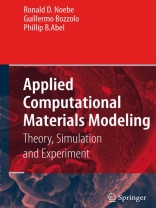While it is tempting to label computational materials modeling as an emerging field of research, the truth is that both in nature and foundation, it is just as much an established field as the concepts and techniques that define it. It is the recent enormous growth in computing power and communications that has brought the activity to the forefi-ont, turning it into a possible com ponent of any modem materials research program. Together with its increased role and visibility, there is also a dynamic change in the way computational modeling is perceived in such a vast field as materials science with its wide range of length and time scales. As the pace of materials research accelerates and the need for often inaccessible information continues to grow, the de mands and expectations on existing modeling techniques have progressed that much faster. Primarily because there is no one technique that can provide all the answers at every length and time scale in materials science, excessive expectations of computational materials modeling should be avoided if pos sible. While it is apparent that computational modeling is the most efficient method for dealing with complex systems, it should not be seen as an alter native to traditional experimentation. Instead there is another option, which is perhaps the one that is most likely to become the defining characteristic of computational materials modeling.
Table of Content
Ab initio modeling of alloy phase equilibria.- Use of computational thermodynamics to identify potential alloy compositions for metallic glass formation.- How does a crystal grow? Experiments, models and simulations from the nano- to the micro-scale regime.- Structural and electronic properties from first-principles.- Synergy between material, surface science experiments and simulations.- Integration of first-principles calculations, calphad modeling, and phase-field simulations.- Quantum approximate methods for the atomistic modeling of multicomponent alloys.- Molecular orbital approach to alloy design.- Application of computational and experimental techniques in intelligent design of age-hardenable aluminum alloys.- Multiscale modeling of intergranular fracture in metals.- Multiscale modeling of deformation and fracture in metallic materials.- Frontiers in surface analysis: Experiments and modeling.- The evolution of composition and structure at metal-metal interfaces: Measurements and simulations.- Modeling of low enrichment uranium fuels for research and test reactors.
Language English ● Format PDF ● Pages 491 ● ISBN 9780387345659 ● File size 28.2 MB ● Editor Guillermo Bozzolo & Ronald D. Noebe ● Publisher Springer US ● City NY ● Country US ● Published 2007 ● Downloadable 24 months ● Currency EUR ● ID 2144893 ● Copy protection Social DRM












